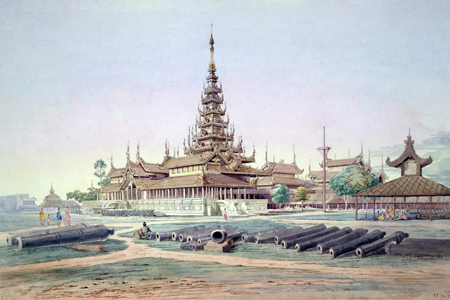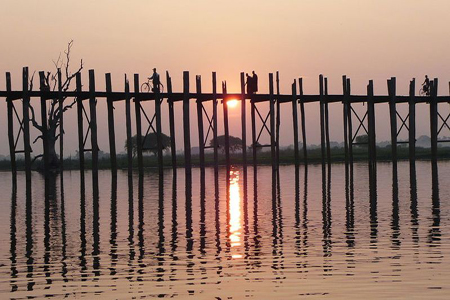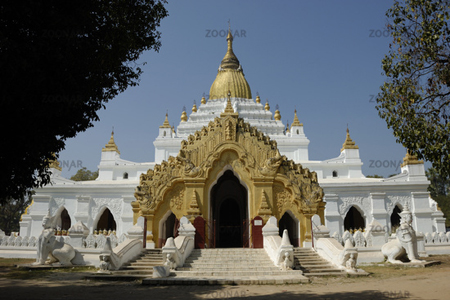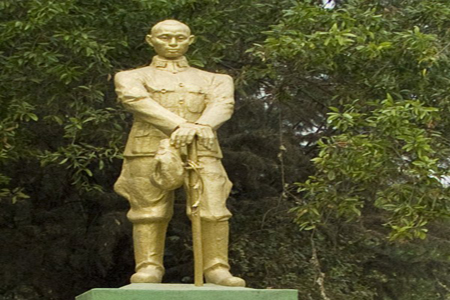Amarapura is also known as The City of Immortals in prosperous times of the past. Amarapura plays an important role as a capital city in central Myanmar which was founded by Bodawpaya (1782-1819), having transferred it from Ava. Bagyidaw (1819-1837), the grandson of Bodawpaya, shifted the capital back to Ava in 1823. Tharrawaddy (1837-1846) who succeeded Bagvidaw, took the capital back to Amarapura after a brief spell at Kyaukmyaung, which remained as such till Mindon chose to found the new capital at Mandalay.

Unlike Mandalay, where the old walls of the Royal City and the Moat are still seen, other than a few indications of where the palace walls stood, the four-corner pagodas, the Watch Tower and the Treasury (which are masonry constructions), Amarapura now do not have a lot of things to do and see. In this area are located the tombs of the two Kings - Bodawpaya and Bagvidaw - carrying the following stone inscriptions in English.
Bodawpaya
Founded the City of Amarapura 1782
Born 1745
Ascended the Throne 1781
Died at Amarapura 1819
Bagyidaw
Born 1784
Ascended the Throne 1819
De-throned 1837
Died at Amarapura 1848
In both the tombs you will find images of the Buddha. The modem Amarapura Village is now known as Taungmyo (or the Southern Town).
Located just 8 miles from Mandalay city, Amarapura will worth you a half-day visit on a day trip from Mandalay. There is a remarkable wooden bridge-U Bein Bridge-named after the Town Mayor of that name, who displayed commendable initiative in salvaging materials from the forsaken Ava Palace for constructing the bridge when the capital was shifted to Amarapura in the latter part of the 18th Century. If you looked very carefully you might even see spots of gilding on some of the teak poles and planks of the bridge which spans the Taung Thaman Lake. The bridge is about 3/4 mile in length and to cover it takes about 15 to 20 minutes. Tired pilgrims and the aged can rest awhile in the covered shelters specially provided along the bridge. That it should have stood for over 200 years does credit to the imagination of the builder and to the strength of the world-famous Burmese teak.
Walk along the bridge, apart from the thrill that one experiences in covering a wooden bridge, built of materials from a royal palace, leads you to a noted shrine, the Kyauktawgyi Pagoda, built by King Pagan in 1847 on the model of the An And A Pagoda at Pagan.

It is a significant confirmation of the beauty of the Ananda that many a Burmese king endeavored to build a pagoda of his own with the Ananda as the inspirational model. Whereas the Ananda is surmised to be the handiwork of Indian architects and craftsmen, the Amarapura Kyauktawgyi is known to be built completely by Burmese architects. The temple itself is raised a few feet from the ground level, has broad steps and huge doorways. Closely resembling the Ananda in beauty and simplicity of construction, this pagoda, unlike the Ãnanda, has wooden beams or rafters. The stone image is a very well-proportioned one, seated on a high location, the head-gear almost touching the ceiling and the face having a brilliant adolescent look. There are also 88 stone figures of the disciples of the Buddha at the back and 12 figures of Manussiha, half man and half beast, all around. This shrine is noted for its frescoes to be seen in the four porches. It is intriguing, somewhat astonishing, to find that a little British influence has crept in-you see figures with tailcoats and felt hats among the figures of the frescoes! The king’s charities throughout the kingdom, religious buildings of various architectural styles that the kings built or renovated at various places, Burmese astronomical (zodiac) charts, details of clothing, customs, and the life generally of that period all these find a place in the frescoes which are still fortunately in a tolerable state of preservation. Of special interest should be the unfinished drawings of frescoes on the northern side of the pagoda in two of the porches.
Re-crossing the Bridge, the next shrine which deserves a visit is the Pahtodawgyi Pagoda (built by King Bagyidaw in 1861) which is known to be one of the largest of its type and, certainly, a very imposing and presentable structure. It goes up in a series of five terraces finishing up with a small sikhara and a final. You will see humor- provoking illustrations and scenes from the Jataka Tales (Stories of the life of the Buddha) in bold, relief, on white marble panels on the three lower terraces. There is also an inscription-stone giving the history of its foundation and a big brass bell.

Besides the twin pagodas, the Shwe Kyet Yet and the Shwe Kyet Kya, of 12th Century A.D, built by a king of Pagan, there is a small noteworthy pagoda - the Nagayon with a distinctive architectural feature embodying the motif of a hooded snake. The Chinese Joss House is of value in that it affords side-light on the Chinese concept of building a temple to house the presentment of the Buddha as distinct from that of the Burmese. This Joss House has a historical aspect too, inasmuch as it has been standing there since the time of Bodawpaya. It is said that when King Mindon switched the capital over to Mandalay, the Chinese stuck fast and would not hear of moving with the King.
The visit to Amarapura would not be complete without a tour of Kyi Thun Khat Village or the Bronze Village. Here, one will find the Buddha images were cast in bronze, generation after generation, by craftsmen with hereditary skills. The metal actually employed is an alloy of bronze and lead. Red earth is used as basic material for the mold and then molten metal poured in through holes in the mold. Here, you will also find a flourishing trade in the manufacture of gongs and cymbals, which are exported abroad. A statue of General Aung San is known to have been cast in this village, as also the silver image for the Kaba Ave Pagoda in Rangoon.

For hundreds of years, Amarapura has had a place as an established center for silk and cotton weaving, especially silk. The brilliant silk longyis that you see Burmese men and women wearing, and which render a Burmese crowd the most colorful anywhere in the world, come mainly from Amarapura.
Appropriately, Amarapura is the location for a training institute for weavers - The Saunder’s Weaving Institute. Started in 1914, the Institute has acquired a reputation for the excellent weavers it turns out. Stipendiary pupils learn hand-loom and fancy-work, weaving by power-looms and, more recently, textile printing. The Lady Principal of the Institute has had training abroad and is assisted by Japanese experts.
